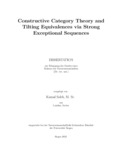Zitierlink:
http://dx.doi.org/10.25819/ubsi/10144Dateien zu dieser Ressource:
| Datei | Beschreibung | Größe | Format | |
|---|---|---|---|---|
| Dissertation_Kamal_Saleh.pdf | 1.92 MB | Adobe PDF |  Öffnen/Anzeigen |
| Dokumentart: | Doctoral Thesis | Titel: | Constructive category theory and tilting equivalences via strong exceptional sequences | Sonstiger Titel: | Konstruktive Kategorientheorie und Tilting-Äquivalenzen via stark-exzeptionelle Sequenzen | AutorInn(en): | Saleh, Kamal |
Institut: | Department Mathematik | Schlagwörter: | Homological algebra, Tilting equivalences, Strong exceptional sequences, Constructive category theory, Representation theory of algebras | DDC-Sachgruppe: | 510 Mathematik | GHBS-Notation: | TEB TBU |
Erscheinungsjahr: | 2022 | Publikationsjahr: | 2022 | Zusammenfassung: | In dieser Arbeit wird ein konstruktiver Zugang für homologische Algebra mit einem Fokus auf (vollständige) stark-exzeptionelle Sequenzen in beschränkten Homotopiekategorien und ihre induzierten exakten Äquivalenzen entwickelt. Dieser Zugang wurde basierend auf Cap und homalg im Computeralgebrasystem GAP implementiert. Zuerst werden die zentralen klassischen Konzepte der homologischen Algebra in einem konstruktiven Rahmen entwickelt, der sich für eine direkte Computerimplementierung eignet. Diese beinhalten die Konstruktion von beschränkten Komplexen, Homotopie- und derivierten Kategorien, in denen zum Beispiel Berechnungen von projektiven und injektiven Auflösungen von beschränkten Komplexen, derivierten Funktoren durchgeführt werden können. Danach wird die Grundlagen für die Durchführung von Berechnungen in triangulierten Kategorien entwickelt. Dies geschieht, indem alle Existenzquantoren und Disjunktionen in den Definitionsaxiomen einer triangulierten Kategorie als konkrete Algorithmen spezifiziert werden. Damit sind wir in der Lage, die stabile Kategorie einer Frobenius-Kategorie und die beschränkte Homotopiekategorie einer additiven Kategorie auf dem Computer zu konstruieren. Gegeben sei ein Körper k, eine k-lineare Hom-endliche additive Kategorie 𝓒 und eine stark-exzeptionelle Sequenz 𝓔 in der beschränkten Homotopiekategorie 𝓚ᵇ(𝓒). In der Arbeit wird ein Algorithmus entwickelt, um die Mitgliedschaft von Objekten in der triangulierten Hülle 𝓔^△ ⊆ 𝓚ᵇ(𝓒) zu entscheiden. Und falls 𝓚ᵇ(𝓒) als triangulierte Kategorie endlich erzeugt ist, kann man insbesondere damit die Vollständigkeit der stark-exzeptionellen Sequenz 𝓔 algorithmisch entscheiden, d.h. entscheiden, ob 𝓔^△=𝓚ᵇ(𝓒). Für eine vollständige stark-exzeptionelle Sequenz 𝓔 benutzen wir sogenannte Postnikov-Systeme, um folgende exakte Äquivalenzen auf dem Computer explizit zu realisieren 𝓓ᵇ(End(T_𝓔)) ≃ 𝓚ᵇ(𝓔^⊕) ≃ 𝓚ᵇ(𝓒) wobei T_𝓔 ≔ E₁⊕⋯⊕Eₙ, 𝓓ᵇ(End(T_𝓔)) die beschränkte derivierte Kategorie der Kategorie End(T_𝓔)-mod der endlich erzeugten End(T_𝓔)-Moduln und 𝓔^⊕ ist die universelle additive Abschlusskategorie von 𝓔 bezeichnen. Diese Methoden ermöglichen den folgenden Spezialfall des Happel'schen Satzes für derivierte Äquivalenzen konstruktiv zu machen: Sei 𝔸 eine endlichdimensionale k-Algebra und T ein Tilting 𝔸-Modul, dessen unzerlegbare Summanden eine vollständige stark-exzeptionelle Sequenz in 𝔸-mod bilden. Dann können die in dieser Arbeit entwickelten Software die induzierten adjungierten derivierten Äquivalenzen explizit ausrechnen: -⊗^𝕃 T : 𝓓ᵇ(End T) ⇄ 𝓓ᵇ(𝔸): ℝHom(T,-). Der konstruktiv-kategorielle Rahmen sowie alle in dieser Arbeit vorgestellten Algorithmen wurden im GAP-Metapaket HigherHomologicalAlgebra implementiert. In this thesis we establish a constructive framework for homological algebra with a special focus on (complete) strong exceptional sequences in bounded homotopy categories and their induced exact equivalences, alongside with a CAP and homalg based implementation of this framework in the computer algebra system GAP. First, we assemble the key concepts in homological algebra in a constructive style that is suitable for a direct computer implementation. This includes constructing bounded complexes, homotopy and derived categories in which we can perform computations like projective and injective resolutions of bounded complexes and derived functors. Then, we set the stage for performing computations in triangulated categories. This is accomplished by stating all the existential quantifiers and disjunctions in the defining axioms of a triangulated category as concrete algorithms. The two primary examples of a triangulated category in this thesis are the stable category of a Frobenius category and the bounded homotopy category of an additive category. Given a field k, a k-linear Hom-finite additive category 𝓒 and a strong exceptional sequence 𝓔 in the bounded homotopy category 𝓚ᵇ(𝓒), we develop an algorithm to check the membership of objects in the triangulated hull 𝓔^△ ⊆ 𝓚ᵇ(𝓒). In particular, if 𝓚ᵇ(𝓒) is finitely generated as a triangulated category, one can employ that to algorithmically decide the completeness of the strong exceptional sequence 𝓔, i.e., decide whether 𝓔^△=𝓚ᵇ(𝓒). For a complete strong exceptional sequence 𝓔, we use the so-called Postnikov systems to provide an explicit construction of exact equivalences 𝓓ᵇ(End(T_𝓔)) ≃ 𝓚ᵇ(𝓔^⊕) ≃ 𝓚ᵇ(𝓒) where T_𝓔 ≔ E₁⊕⋯⊕Eₙ,Eᵢ∈ 𝓔, 𝓓ᵇ(End(T_𝓔)) denotes the bounded derived category of the category End(T_𝓔)-mod of finitely generated End(T_𝓔)-modules, and 𝓔^⊕ is the universal additive closure category of 𝓔. These techniques enable us to make the following special case of Happel's theorem for derived equivalences constructive: Let 𝔸 be a finite dimensional k-algebra and T a tilting 𝔸-module whose indecomposable summands form a complete strong exceptional sequence in 𝔸-mod. Then we can compute the induced adjoint derived equivalences -⊗^𝕃 T : 𝓓ᵇ(End(T)) ⇄ 𝓓ᵇ(𝔸): ℝHom(T,-) The categorical framework along with all algorithms presented in this thesis are implemented in the GAP meta-package HigherHomologicalAlgebra. |
DOI: | http://dx.doi.org/10.25819/ubsi/10144 | URN: | urn:nbn:de:hbz:467-22326 | URI: | https://dspace.ub.uni-siegen.de/handle/ubsi/2232 |
| Enthalten in den Sammlungen: | Hochschulschriften |
Diese Ressource ist urheberrechtlich geschützt. |
Seitenansichten
1.345
checked on 25.11.2024
Download(s)
327
checked on 25.11.2024
Google ScholarTM
Prüfe
Prüfe
Alle Ressourcen in diesem Repository sind urheberrechtlich geschützt, soweit nicht anderweitig angezeigt.

